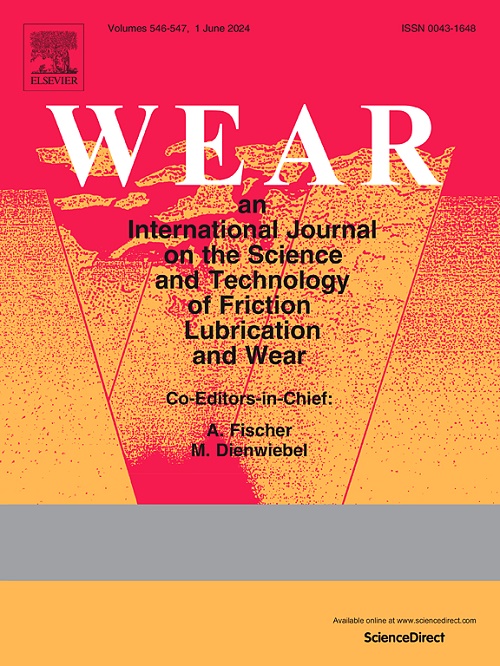Innovative small-scale testing to investigate thermo-mechanical damage in tread-braked railway wheel steel paired with various types of cast iron
IF 5.3
1区 工程技术
Q1 ENGINEERING, MECHANICAL
引用次数: 0
Abstract
This study investigates the thermo-mechanical damage to wheel steel caused by the use of different types of grey cast iron as brake materials. Both untreated and austempered specimens of cast iron were tested to evaluate their wear behaviour and frictional properties under controlled conditions employing an innovative small-scale testing rig called “4-contact machine”. The experiments measured temperature on the specimens' contact surface, wear, friction coefficient and power developed. An in-depth metallographic analysis of all wheel samples was also conducted to determine the impact on wheel steel integrity. Significant findings include the formation of a martensitic transfer layer on the wheel samples’ surface, resulting from the high temperature and pressure during braking. This layer, being harder than the unaltered wheel steel, highlights the thermo-mechanical stress imposed on the wheel. Austempered cast iron brake samples showed superior performance with reduced wear and lower friction coefficients compared to untreated samples. The results emphasize the need for improved brake materials to mitigate thermo-mechanical damage to wheels, enhancing both safety and longevity of railway brake systems. This research contributes to the development of more resilient brake materials, providing valuable insights for the railway industry in optimizing material selection for enhanced operational efficiency and reduced maintenance costs. These advantages are particularly notable compared to composite materials, as austempered cast iron offers comparable or superior performance without the higher costs or vehicle modifications required for composites, all while maintaining its eco-friendly nature.
创新的小型试验研究了不同类型的铸铁对踏面制动铁路车轮钢的热机械损伤
本文研究了使用不同类型的灰口铸铁作为制动材料对车轮钢造成的热机械损伤。对未经处理和等温处理的铸铁试样进行了测试,以评估它们在受控条件下的磨损行为和摩擦性能,测试采用了一种名为“四接触机”的创新小型测试设备。实验测量了试样接触面温度、磨损、摩擦系数和功率发展情况。还对所有车轮样品进行了深入的金相分析,以确定对车轮钢完整性的影响。重要的发现包括车轮样品表面马氏体传递层的形成,这是由于制动过程中的高温和高压造成的。这一层,是硬比未改变车轮钢,突出热机械应力施加在车轮上。与未经处理的样品相比,奥氏体热处理的铸铁制动器样品具有更低的磨损和更低的摩擦系数。研究结果强调需要改进制动材料,以减轻车轮的热机械损伤,提高铁路制动系统的安全性和寿命。这项研究有助于开发更具弹性的制动材料,为铁路行业优化材料选择提供有价值的见解,以提高运营效率和降低维护成本。与复合材料相比,这些优势尤其显著,因为等温铸铁提供了相当或更优越的性能,而不需要复合材料的更高成本或车辆改装,同时保持了其环保性质。
本文章由计算机程序翻译,如有差异,请以英文原文为准。
求助全文
约1分钟内获得全文
求助全文
来源期刊

Wear
工程技术-材料科学:综合
CiteScore
8.80
自引率
8.00%
发文量
280
审稿时长
47 days
期刊介绍:
Wear journal is dedicated to the advancement of basic and applied knowledge concerning the nature of wear of materials. Broadly, topics of interest range from development of fundamental understanding of the mechanisms of wear to innovative solutions to practical engineering problems. Authors of experimental studies are expected to comment on the repeatability of the data, and whenever possible, conduct multiple measurements under similar testing conditions. Further, Wear embraces the highest standards of professional ethics, and the detection of matching content, either in written or graphical form, from other publications by the current authors or by others, may result in rejection.
 求助内容:
求助内容: 应助结果提醒方式:
应助结果提醒方式:


